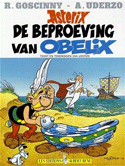A family of marks characterised by the -ix
 HvJ EG, 18 December 2008, zaak C-16/06 P, Les Éditions Albert René Sàrl tegen Orange A/S
HvJ EG, 18 December 2008, zaak C-16/06 P, Les Éditions Albert René Sàrl tegen Orange A/S
Obelix tegen Mobilix. Ook even kort: Gemeenschapsmerkenrecht. Oppositie op grond van ouder Gemeenschap- en nationaal woordmerk OBELIX (de naam het bekende stripfiguur)tegen aanvraag woordmerk MOBILIX. Oppositie afgewezen.
“95. Fourthly, it must be stated that the appellant is relying on a misinterpretation of the judgment under appeal, in claiming that the Court of First Instance’s reasoning in paragraph 79 of the judgment under appeal infringes the principle of trade mark law that the more well known an earlier mark or the greater its distinctiveness, the greater the likelihood of confusion.
96. In fact, in paragraph 79 of the judgment under appeal the Court of First Instance merely stated, in a factual assessment, which it is not for the Court to review, that the ‘OBELIX’ sign conveys a reference to a famous character from a comic strip and, as a result, is conceptually different from the ‘MOBILIX’ sign; it did not thus rule on the well known nature of the OBELIX trade mark.
97. Inasmuch as, fifthly, the appellant calls into question the Court of First Instance’s application of the ‘counteraction’ theory, it must be observed that that court examined all the evidence which, in accordance with settled case-law, must be taken into consideration in order to carry out a global assessment of the likelihood of confusion.
98. Case-law shows that the global assessment of the likelihood of confusion implies that conceptual differences between two signs may counteract aural and visual similarities between them, provided that at least one of those signs has, from the point of view of the relevant public, a clear and specific meaning, so that the public is capable of grasping it immediately (see, to that effect, Case C-361/04 P Ruiz-Picasso and Others v OHIM [2006] ECR I-643, paragraph 20, and Case C-206/04 P Mühlens v OHIM [2006] ECR I-2717, paragraph 35 et seq.).
99. Therefore, the Court of First Instance cannot be criticised for having applied the ‘counteraction’ theory in paragraph 81 of the judgment.
100. Finally, sixthly, as regards the appellant’s argument derived from the fact that it is the proprietor of a family of marks characterised by the ‘-ix’ suffix, the Court notes that, although the appellant has invoked a number of earlier marks which, it submits, are part of that family, it based its opposition solely on the earlier mark OBELIX.
101. However, it is where an opposition is based on the existence of several marks with shared characteristics enabling them to be regarded as part of the same ‘family’ or ‘series’ of trade marks that account should be taken, in the assessment of the likelihood of confusion, of the fact that, in the case of a ‘family’ or ‘series’ of trade marks, a likelihood of confusion results from the fact that the consumer may be mistaken as to the provenance or origin of goods or services covered by the trade mark applied for and considers erroneously that the latter trade mark is part of that family or series of marks (see, to that effect, Ponte Finanziaria v OHIM and F.M.G Textiles (formerly Marine Enterprise Projects), paragraphs 62 and 63).
102/ Consequently, in the light of the foregoing, the second part of the second ground of appeal must be rejected as in part inadmissible and in part unfounded.”
Lees het arrest hier.





















































































